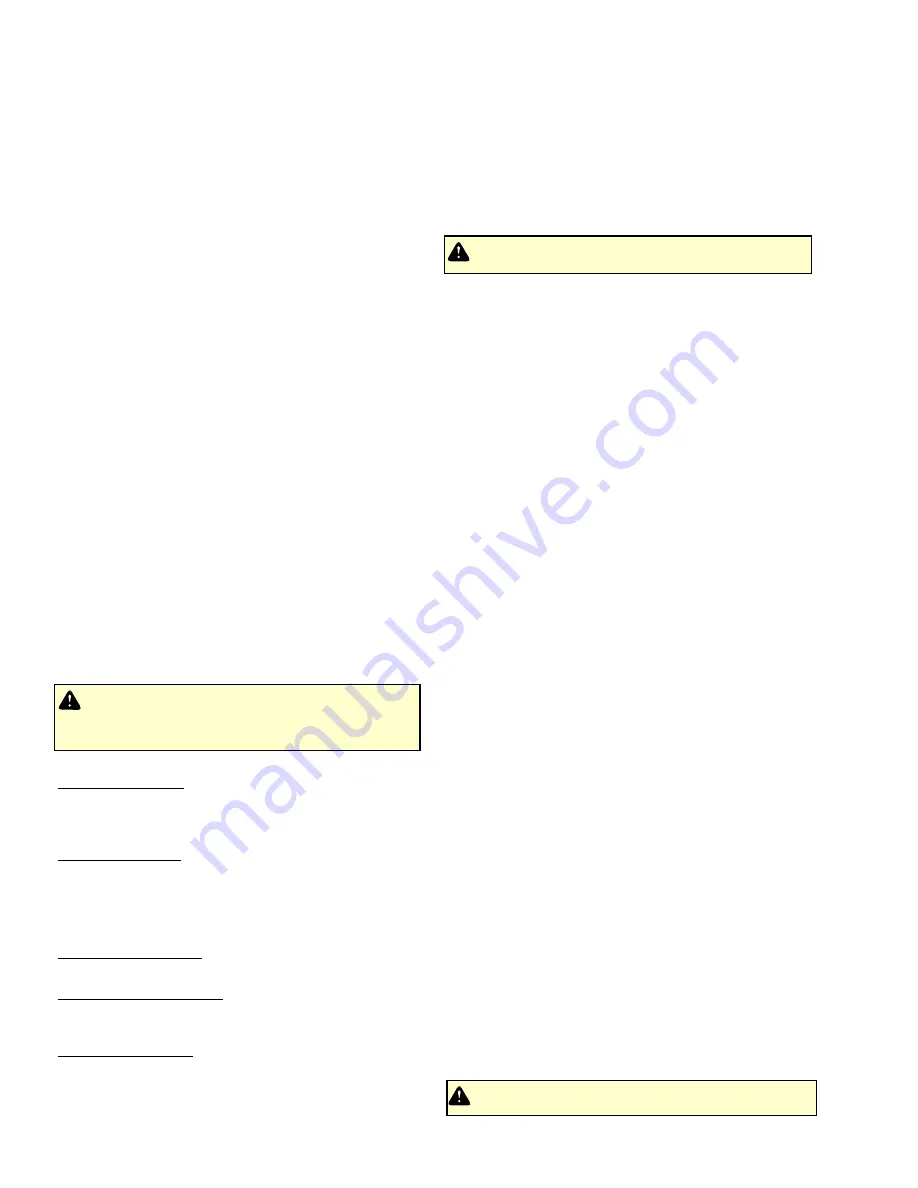
Air Purging Procedure
1. Fill pressure tank with proper glycol mixture and pressurize
8 to 10 psig. At 7 psig the coolant tank pressure cap will
open and coolant will flow into the overflow tank.
2. Connect the charging tank hose (with refrigerant style
connector) to either the Schrader valve located near the
outdoor unit coil on the lower glycol header entering the
bottom of the outdoor unit coil, near the bottom of the
accumulator on the left side of the unit, or to the Schrader
valve located near the glycol strainer/filter (positioned be-
tween the engine mounts on the right side of the unit).
3. Open shutoff valve on pressure tank and watch for the
glycol level to rise without air bubbles.
4. Close the shutoff valve and start the engine with the
Service Analyzer.
5. Ramp engine speed to 3000 rpm and open the shutoff valve
again until the glycol level in the overflow tank rises again.
6. Close the shutoff valve and allow the engine to run for a
few minutes.
7. Repeat steps 5 and 6.
8. It is possible that the engine might overheat during this
process if there is too air much in the glycol system. If this
occurs, turn off engine and repeat Step 3. Attempt engine
start again and repeat Steps 5 and 6.
9. Use the Service Analyzer to turn engine off.
10. Let system settle for a few minutes and then repeat Step 3.
11. The coolant system should now be fully purged of air.
Remove Service Analyzer and pressure tank.
SAFETY CONTROLS
The system is equipped with safety controls to protect the unit.
The safety controls are located in the engine compartment.
High Pressure Cutout - This control is located in the refrigerant
discharge line and will open in case of overload conditions on
the outdoor unit. Cutout opens at 405 psig and closes at 265
psig.
Low Pressure Cutout - This control is located in the refrigerant
suction line and protects from loss of charge. Cutout opens at
6 psig, closes at 12 psig.
The engine is also equipped with safety controls as follows.
Engine Overtemperature - This control protects the engine from
overload or loss of coolant. Sensor will trip at 225
°
F.
Engine Oil Pressure Control - This control protects the engine
from loss of oil pressure (it is bypassed during engine startup)
Limit trips if pressure is less than 15 psig.
Engine Speed Monitor - This sensor is located on the engine
camshaft and monitors engine speed, protects against in-
correct speed, underspeed (850 RPM) and overspeed (3600
RPM). It functions through the Engine Control System
(ECS).
SYSTEM START-UP AND ADJUSTMENTS
The initial start-up of the unit requires the following additional
procedures.
1. When the gas supply is initially connected to the unit, the
gas piping may be full of air. In order to purge this air, it is
recommended that the plug on the gas line be loosened
until the odor of gas is detected. When gas is detected,
immediately retighten the plug and check for leaks.
Allow five minutes for any gas to dissipate before continu-
ing with the start-up procedure.
2. All electrical connections made in the field and in the
factory should be checked for proper tighteness.
Ignition System Checkout/Adjustment
1. Turn control system power ON, and turn the gas supply OFF.
2. Check the control module operation as follows:
a. Set thermostat above room temperature to call for heat,
unless the outdoor temperature is above 80
°
F. If it is
above 80
°
F, set the thermostat to call for cooling. Refer
to operation instructions for thermostat if necessary.
b. The control module will go thru self-check (for 10 sec-
onds).
c. The starter solenoid will engage the engine starter.
d. The starter will attempt to start the engine (maximum
cranking time of 10 seconds).
e. Turn the thermostat down to end the call for heat (or up
to end call for cooling).
3. Turn the gas supply ON.
4. Turn the outdoor unit and indoor unit power off and wait for
30 seconds..
5. Start the system as follows:
a. Turn the outdoor power on first and then turn on indoor
power.
b. Set the thermostat above room temperature to call for
heat or below room temperature to call for cooling if
outdoor temperature is above 80
°
F.
c. System will go thru the start sequence described above.
d. System will start and run at 1500 RPM for 2 minutes.
e. System will then respond to the demand from the
thermostat by either increasing or decreasing speed.
f. Corresponding changes in the indoor blower speed will
occur to match the engine speed.
g. Set thermostat below room temperature and allow sys-
tem to run in cooling mode for five minutes. Perform
the air purging procedure again.
With the engine in operation, paint the pipe joints and valve gas
lines with a rich soap and water solution.
Bubbles indicate gas leakage. To stop leaks, tighten joints and
screws. If the leak persists, replace the component.
WARNING: DO NOT omit this test! NEVER use a flame
to check for gas leaks.
WARNING: Main power supply to the unit must still be
interrupted at the main power disconnect switch before
any service or repair work is to be done to the unit. Do
not rely on the control system to cut power to the unit.
WARNING: No smoking or using an open flame when
gas is flowing.
515.35-N6Y
8
Unitary Products Group























